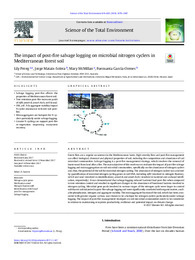Please use this identifier to cite or link to this item:
https://hdl.handle.net/11000/7171Full metadata record
| DC Field | Value | Language |
|---|---|---|
| dc.contributor.author | Pereg, Lily | - |
| dc.contributor.author | Mataix Solera, Jorge | - |
| dc.contributor.author | McMillan, Mary | - |
| dc.contributor.author | García Orenes, Fuensanta | - |
| dc.contributor.other | Departamentos de la UMH::Agroquímica y Medio Ambiente | es |
| dc.date.accessioned | 2021-02-25T08:12:13Z | - |
| dc.date.available | 2021-02-25T08:12:13Z | - |
| dc.date.created | 2017-11-29 | - |
| dc.date.issued | 2021-02-25 | - |
| dc.identifier.issn | 0048-9697 | - |
| dc.identifier.issn | 1879-1026 | - |
| dc.identifier.uri | http://hdl.handle.net/11000/7171 | - |
| dc.description.abstract | Forest fires are a regular occurrence in the Mediterranean basin. High severity fires and post-fire management can affect biological, chemical and physical properties of soil, including the composition and abundance of soil microbial communities. Salvage logging is a post-fire management strategy, which involves the removal of burntwood fromland after a fire. The main objective of thiswork was to evaluate the impact of post-fire salvage logging and microaggregation on soil microbial communities, specifically on the abundance of nitrogen cyclers and, thus, the potential of the soil for microbial nitrogen cycling. The abundance of nitrogen cyclers was assessed by quantification of microbial nitrogen cycling genes in soil DNA, including nifH (involved in nitrogen fixation), nirS/K and nosZ (involved in denitrification), amoA-B and amoA-Arch (involved in bacterial and archaeal nitrification, respectively). It was demonstrated that salvage logging reduced bacterial load post-fire when compared to tree retention control and resulted in significant changes to the abundance of functional bacteria involved in nitrogen cycling. Microbial gene pools involved in various stages of the nitrogen cycle were larger in control soil than in soil subjected to post-fire salvage logging and were significantly correlated with organicmatter, available phosphorous, nitrogen and aggregate stability. The microaggregate fraction of the soil,which has been associated with greater organic carbon, was shown to be a hotspot for nitrogen cyclers particularly under salvage logging. The impact of post-fire management strategies on soil microbial communities needs to be considered in relation to maintaining ecosystem productivity, resilience and potential impact on climate change | es |
| dc.description.sponsorship | This work was supported by funding from Salvador de Madariaga Program of MECD of Spain for the mobility of researchers and by the University of New England, Australia. | - |
| dc.description.sponsorship | The project was also supported by the project “POSTFIRE_CARE” - Ref.: CGL2016-75178-C2-1-R [AEI/FEDER, UE], financed by the Spanish Research Agency (AIE) and the “European Union through European Funding for Regional Development (FEDER)” | - |
| dc.format | application/pdf | es |
| dc.format.extent | 9 | es |
| dc.language.iso | eng | es |
| dc.rights | info:eu-repo/semantics/openAccess | es |
| dc.subject | Nitrogen cycle genes | es |
| dc.subject | Nitrification amoA | es |
| dc.subject | Nitrogen fixation nifH | es |
| dc.subject | denitrification nirK/S nosZ | es |
| dc.subject | post fire management | es |
| dc.subject | Salvage logging | es |
| dc.subject.other | 9 - Geografía e Historia | es |
| dc.title | The impact of post-fire salvage logging on microbial nitrogen cyclers in Mediterranean forest soil | es |
| dc.type | info:eu-repo/semantics/article | es |
| dc.identifier.doi | 10.1016/j.scitotenv.2017.11.147 | - |
| dc.relation.publisherversion | https://doi.org/10.1016/j.scitotenv.2017.11.147 | - |

View/Open:
6-Pereg et al. STOTEN 2018(EMBARGO).pdf
894,05 kB
Adobe PDF
Share:
.png)
